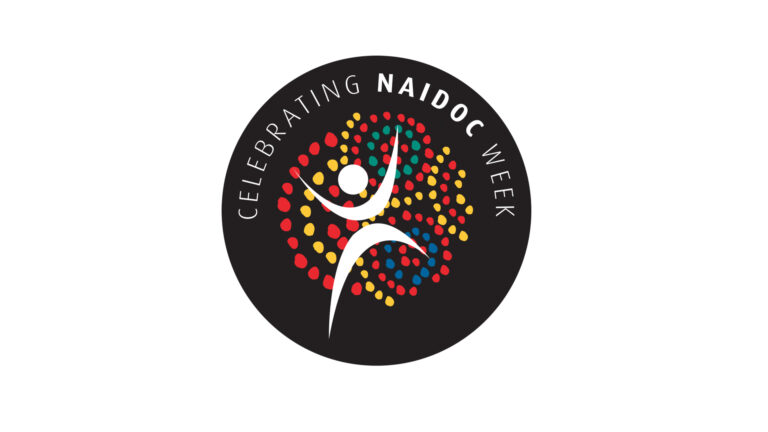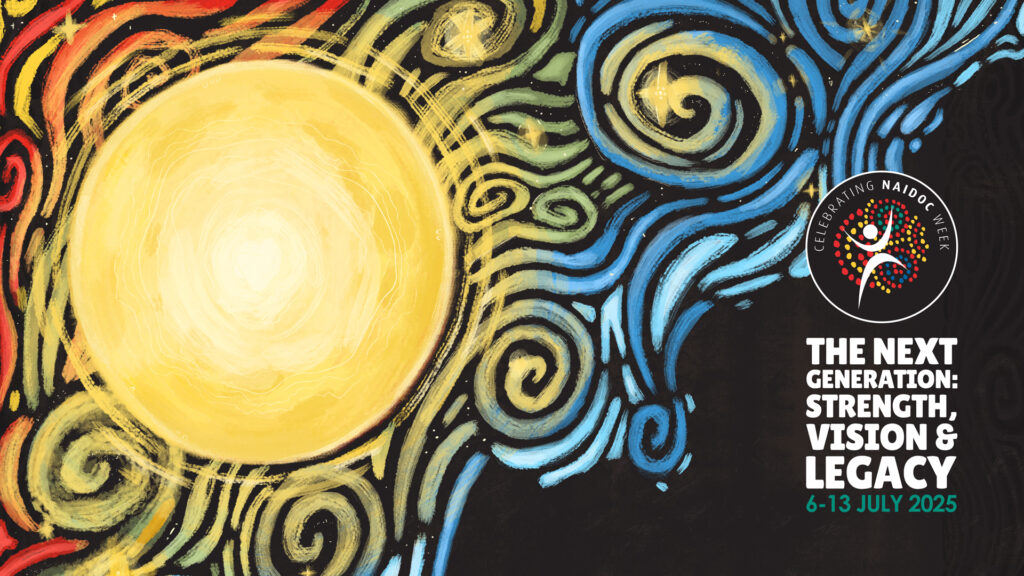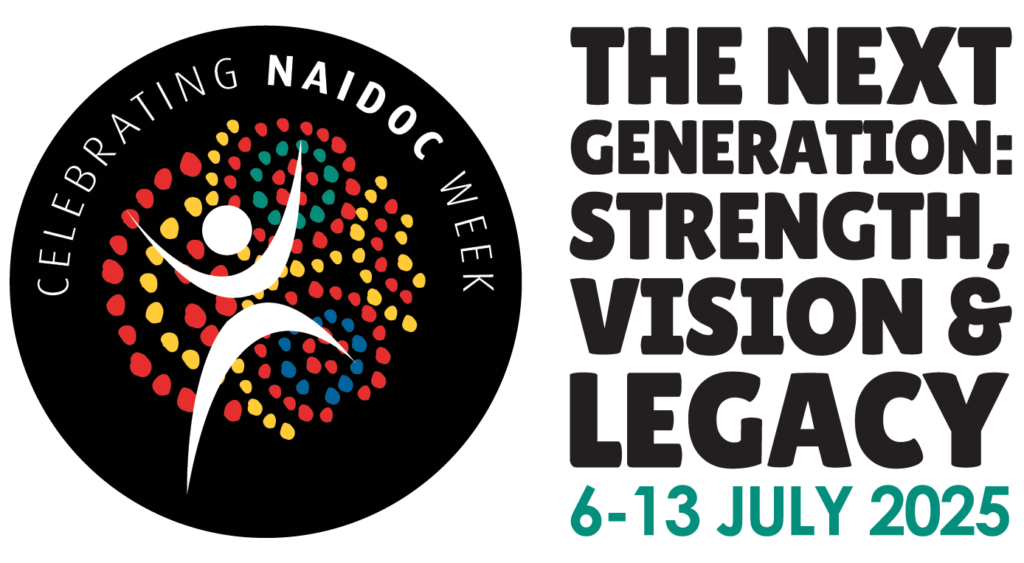Blog Cultural Lanyards that Speak Identity: Celebrating NAIDOC Week Through Design

Cultural lanyard designs can play an important part in NAIDOC week, by allowing wearers to showcase Indigenous pride, identity and art, and therefore show their cultural pride and connection.
There are many ways this can be done, as lanyards are a unique way to use wearable art to showcase specific designs and messages with ease. Most significantly, at public events, many people like to show their cultural pride through wearable accessories. Incorporating indigenous identity and artworks into the designs, such as First Nations symbols, allows wearers to publicly display their culture. This is important, as visual identity plays a massive role in honouring community, country and culture.
Additionally, lanyards can be tools to promote reconciliation messaging, as their visual nature allows wearers to demonstrate feelings of recognition, support, and solidarity. This, in turn, further builds community belonging, as it enables a group of people to come together under one central message that they believe in. The artistic nature of a lanyard, combined with its ability to bring people together, therefore makes it a fantastic artistic and community-building tool that can have a real impact.
However, the artistic appeal of a lanyard isn’t its only important aspect. In this article, we will discuss how NAIDOC week lanyards also require a strong commitment to ethical design and indigenous consultation, and the importance of allowing them to act as a source of youth inspiration and inclusive celebration across the country.
We would like to acknowledge that The Wristband Co. is located on the traditional lands for the Kaurna people, and we respect their spiritual relationship with their Country. We also acknowledge the Kaurna people as the custodians of the Adelaide region and that their cultural and heritage beliefs are still as important to the living Kaurna people today.
Cultural lanyard designs often incorporate traditional Indigenous symbols and motifs into wearable art that communicates a strong connection to identity and heritage. For example, dot painting, which originates in Central Australia, uses intricate dot designs to tell sacred narratives or depict culturally significant sites.
Another common feature is the Dhari, a ceremonial headdress worn by the people of the Torres Strait Islands, which is also incorporated into the flag, meaning it carries a high level of cultural significance. Woven patterns are also commonly used, which is a nod to Indigenous traditions of craftsmanship and community.
Colour is also an important feature, as in Indigenous art, it symbolises spiritual and ancestral meaning, and therefore holds deep cultural value when adapted into wearable art. Red, black, and yellow are very important to the Aboriginal community, as reflected on their flag. Black represents the people, while red symbolises the earth and a connection to the land, and yellow represents the sun. Similar connection to colour can also be found within the Torres Strait community, as the colours of green and blue on their flag represent the land and the sea, respectively.
Wearable art can also incorporate linework and abstract forms, which are an important part of Dreamtime-based storytelling. These serve as visual maps that depict ancestral movements, community structures, and sacred journeys that are significant to the wearer and their community.
The colours and form of the artworks incorporated into wearable designs often reflect specific cultural groups. Those who identify as Aboriginal will often use the red, black, and yellow from their flags to show a connection to their people and land. Similarly, those who identify as Torres Strait Islanders will use blue and green elements drawn from their flag to demonstrate their identity and cultural pride.

When incorporating Indigenous art into any product, including lanyards, the most important aspect you need to get right is obtaining the right permission, attribution and consultation.
Indigenous designs typically carry generations’ worth of knowledge, identity and cultural significance, and are therefore highly sacred to their respective communities. Misusing cultural designs carries the risk of not only using the symbols incorrectly but also misappropriating the culture that created them.
This therefore demands full consultation with Indigenous groups, to ensure that permission is gained to use the designs, and to allow them to oversee the process so that the designs are used correctly. The best way to do this is through formal cultural protocols within your company, as well as agreements with local Indigenous artists, who can guide you on setting ethical standards and make sure that you undertake your design process correctly.
If you don’t work closely with Indigenous groups, the chances of cultural misappropriation are high, and you may be using sacred traditions without the proper permission.
Employing best practices throughout your design process is the right way to ensure all Indigenous artworks and symbolism are used in the right way. These include entering into licensing agreements with local artists, ensuring that they are paid appropriate royalties once your product is on the market, and creating a community benefit agreement to ensure you are investing back into the Indigenous community.
One of the more powerful ways that lanyards can have an impact on NAIDOC week is by inspiring and empowering youth to understand the cultural significance of the First Nations people and to fully participate in NAIDOC week.
Schools often utilise lanyards for this purpose, by incorporating lanyards into NAIDOC-specific events, assemblies, and lesson plans to raise awareness and to get students thinking about the messaging behind the week.
The lanyards also serve as fantastic cultural learning tools in the classroom. The symbolic designs and colours contained within the lanyards allow students to learn about their significance to Indigenous communities, which supports their cultural learning and encourages personal reflection.
Additionally, lanyards are fully customisable, which means schools can ensure their NAIDOC week lanyards are reflective of local traditions. This creates a sense of ownership and identity, as students are able to engage with the Indigenous culture local to them, which in turn increases participation.
The customisation of lanyards also means that youth-oriented designs can be created, allowing teachers and local Indigenous groups to spark targeted conversations with students about culture, history, and pride.

Lanyards are one of the best multi-purpose tools, as they can be designed and created in a way that suits anyone. No matter what your needs are, lanyards are fully customisable to the wearer, allowing them to be extremely inclusive for all wearers.
This is demonstrated through the way a lanyard can be made accessible for any wearer. Design specifications can ensure that the lanyards are created to promote sensory comfort by using soft materials and non-irritating components. These components can include highly adaptive features, such as breakaway clasps, larger badge holders, and even tactile symbols to suit every need.
Ensuring that lanyards are inclusive is central to the NAIDOC cause, as by promoting inclusivity, the meaning and reach of cultural celebration are extended even further which allows for a wider group of people to participate.
This means that all institutions, from schools, workplaces, and community events, can use NAIDOC lanyards to promote participation, as they can ensure that the lanyards fit the needs of everyone within their group.
While NAIDOC week is steeped in historical tradition, lanyards used during this time are enhanced by modern design tools to further the cultural experience. Digital technology, therefore, allows storytelling to extend beyond the physical item and creates an opportunity for people to deeply engage in culture and traditions.
A great way to do this is by using QR codes, NFC tags, and AR features as a part of the design to embed specific messages into the lanyard. This includes embedding stories, elder messages or historical facts that wearers and those around them can easily access. Additionally, the digital design nature of lanyards means that design platforms can be set up to engage with youth or specific communities, and allow them to customise their pieces to represent their own identity and culture.
Digital personalisation tools are key when it comes to creating NAIDOC lanyards, as they empower individuals to create something that is of significance to them. Whether this is embedding mob identity, family stories, or regional designs into the lanyard designs, the options are endless and create a platform for a truly important piece of wearable art to be made.
As we mentioned earlier, creating authentic cultural products requires close consultation and Indigenous-led design to ensure accuracy and respect throughout the entire design process. Allowing First-Nations members to consult and lead design work will result in a true reflection of identity, culture, and community while still ensuring that the correct permissions and accurate processes are maintained.
By partnering with local artists and creatives, there is real benefit to be had for community economies. Commissioning artwork and paying royalties helps to support Indigenous livelihoods and ensures that there is a continued reinvestment in the Indigenous community. Additionally, the exposure and awareness that working with Indigenous creatives raises increases their visibility and empowers them to tell their stories to a wider group of people.
Engaging in a co-created design process, therefore, results in more meaningful and accepted cultural items, as the right steps have been taken to ensure the Indigenous community is appropriately incorporated and benefited at all times.
There are some great initiatives already out there that help to integrate Indigenous creatives in design development. For example, the Indigenous Art Code helps artists to engage in ethical and meaningful commercial opportunities to promote and sell their art. Additionally, the Indigenous Art Centre Alliance supports culturally strong, best-practice Indigenous art enterprises within Far North Queensland and the Torres Strait.
Lanyards serve so much more than a practical purpose, as they are also a tool to communicate specific messages. This is particularly important for the NAIDOC initiative, as its purpose contains important messages which can be communicated via lanyards.
NAIDOC lanyards can be used well beyond NAIDOC week; wearing them year-round keeps NAIDOC values visible in workplaces, schools, and in the general public. Specific design elements that speak to an aspect of cultural identity communicate messages of allyship, heritage, and social responsibility for both the wearer and those around them.
It is well known that merchandise can be a powerful tool when it comes to spreading a special message, and due to their easily wearable nature, lanyards are a key part of this. NAIDOC lanyards can open conversations and keep messages at the forefront of people’s minds, while also spreading education and giving people a chance to learn more. Recurring use therefore helps to normalise cultural pride and increases recognition for these important messages.
The growing popularity of eco-friendly lanyards reflects a broader shift towards sustainability, one that resonates strongly with Indigenous principles of land care and guardianship.
Today, new “green” materials such as organic cotton, bamboo, and recycled PET (plastic sourced from bottles) are helping to reduce the environmental footprint of lanyards, offering a more responsible alternative to conventional synthetic options.
The Wristband Co.’s commitment to sustainability is embedded in both the materials and processes used in its lanyard production. Through advanced heat sublimation printing, ink is directly infused into the polyester fabric, resulting in vibrant, long-lasting designs that won’t fade or peel. This method also reduces waste by minimising the need for frequent replacements, reinforcing a more considered approach to production.
By prioritising waste reduction, ethical material sourcing, and low-impact manufacturing, The Wristband Co. ensures its products are not only durable but also aligned with environmental best practices.
These choices reflect a deeper respect for Country and culture, echoing Indigenous values of resourcefulness, stewardship, and care for the land, core principles that guide us towards both cultural and ecological integrity.
Lanyards are commonly used as a branding tool, even during NAIDOC week. However, brands that do wish to promote branding alongside honouring Indigenous tradition need to strike a careful balance to ensure they are appropriately engaging with Indigenous culture.
Strong consultation with the indigenous groups is key, as they can guide you on how to balance branding your business alongside the messages and traditions of NAIDOC week. Additionally, ensuring transparency throughout the whole process, administering appropriate royalties, and engaging in authentic co-design will not only better represent cultural identity but will also foster a relationship of trust and impact.
A fantastic example of a brand that got it right was the campaign conducted by Palmolive, in which the brand worked alongside First Nations’ groups to tell important Indigenous stories and highlight the underrepresentation of First Nations peoples in the native agriculture supply chain in various products.
It’s important that you steer clear of superficial engagement with Indigenous tradition and approach the process from a meaningful place, as otherwise, you run the risk of tokenism or misappropriation, which can be extremely harmful for indigenous communities.
During NAIDOC week, and beyond, lanyards can be a powerful tool to enhance cultural awareness and spread the core values and experiences of Indigenous people throughout Australia.
Wearable art is a fantastic way to communicate visual storytelling, as well as providing an opportunity to engage with youth education and community-led innovation. As a result, lanyards can extend beyond their usual purpose to create a real cultural impact that is a living expression of voice, pride, and purpose.
However, it is key that this is done in the right way, by ensuring the correct level of consultation and collaboration is incorporated into the design process to properly reflect NAIDOC and Indigenous traditions. Supporting Indigenous-led initiatives and creators is becoming more important than ever, as it helps to promote a cultural identity that is infused into the fabric of our country.
If you are looking to create lanyards for the upcoming NAIDOC week, we can help. Here at The Wristband Co., we are committed to creating and supporting culturally safe, ethical merchandise throughout our entire design process. You can call us on 08 8363 485 or send an email to [email protected] to speak to one of our friendly staff members who can help get your lanyard design underway.



Join our mailing list to receive product information, endless inspiration and 10% off your next order!
Monday – Friday 8:30 AM-8:30 PM
Saturday 10:00 AM-5:00 PM
Sunday CLOSED
38 Little Rundle Street Kent Town SA 5067
08 8363 4850
ABN: 62 239 772 879
The Wristband Co. is located on the traditional lands for the Kaurna people, and we respect their spiritual relationship with their Country. We also acknowledge the Kaurna people as the custodians of the Adelaide region and that their cultural and heritage beliefs are still as important to the living Kaurna people today.
Payments Accepted